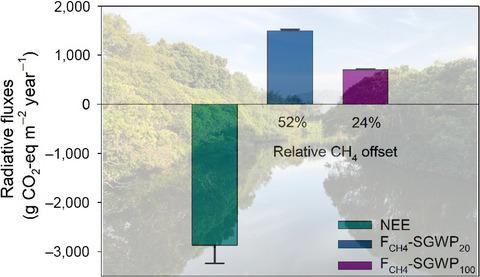当前位置:
X-MOL 学术
›
Glob. Change Biol.
›
论文详情
Our official English website, www.x-mol.net, welcomes your feedback! (Note: you will need to create a separate account there.)
Methane emissions reduce the radiative cooling effect of a subtropical estuarine mangrove wetland by half.
Global Change Biology ( IF 11.6 ) Pub Date : 2020-06-23 , DOI: 10.1111/gcb.15247 Jiangong Liu 1 , Yulun Zhou 1 , Alex Valach 2 , Robert Shortt 2 , Kuno Kasak 2, 3 , Camilo Rey-Sanchez 2 , Kyle S Hemes 4 , Dennis Baldocchi 2 , Derrick Y F Lai 1, 5
Global Change Biology ( IF 11.6 ) Pub Date : 2020-06-23 , DOI: 10.1111/gcb.15247 Jiangong Liu 1 , Yulun Zhou 1 , Alex Valach 2 , Robert Shortt 2 , Kuno Kasak 2, 3 , Camilo Rey-Sanchez 2 , Kyle S Hemes 4 , Dennis Baldocchi 2 , Derrick Y F Lai 1, 5
Affiliation

|
The role of coastal mangrove wetlands in sequestering atmospheric carbon dioxide (CO2) and mitigating climate change has received increasing attention in recent years. While recent studies have shown that methane (CH4) emissions can potentially offset the carbon burial rates in low‐salinity coastal wetlands, there is hitherto a paucity of direct and year‐round measurements of ecosystem‐scale CH4 flux (FCH4) from mangrove ecosystems. In this study, we examined the temporal variations and biophysical drivers of ecosystem‐scale FCH4 in a subtropical estuarine mangrove wetland based on 3 years of eddy covariance measurements. Our results showed that daily mangrove FCH4 reached a peak of over 0.1 g CH4‐C m−2 day−1 during the summertime owing to a combination of high temperature and low salinity, while the wintertime FCH4 was negligible. In this mangrove, the mean annual CH4 emission was 11.7 ± 0.4 g CH4‐C m–2 year−1 while the annual net ecosystem CO2 exchange ranged between −891 and −690 g CO2‐C m−2 year−1, indicating a net cooling effect on climate over decadal to centurial timescales. Meanwhile, we showed that mangrove FCH4 could offset the negative radiative forcing caused by CO2 uptake by 52% and 24% over a time horizon of 20 and 100 years, respectively, based on the corresponding sustained‐flux global warming potentials. Moreover, we found that 87% and 69% of the total variance of daily FCH4 could be explained by the random forest machine learning algorithm and traditional linear regression model, respectively, with soil temperature and salinity being the most dominant controls. This study was the first of its kind to characterize ecosystem‐scale FCH4 in a mangrove wetland with long‐term eddy covariance measurements. Our findings implied that future environmental changes such as climate warming and increasing river discharge might increase CH4 emissions and hence reduce the net radiative cooling effect of estuarine mangrove forests.
中文翻译:

甲烷排放将亚热带河口红树林湿地的辐射冷却效果降低了一半。
近年来,沿海红树林湿地在隔离大气中的二氧化碳(CO 2)和缓解气候变化中的作用日益受到关注。尽管最近的研究表明,甲烷(CH 4)的排放量可能会抵消低盐度沿海湿地的碳埋藏率,但迄今为止,缺乏直接和全年的生态系统规模CH 4通量(F CH4)测量值。红树林生态系统。在这项研究中,我们基于3年的涡度协方差测量结果,研究了亚热带河口红树林湿地中生态系统规模F CH4的时间变化和生物物理驱动力。我们的结果表明,每天的红树林F CH4由于高温和低盐度的共同作用,夏季达到了超过0.1 g CH 4 -C m -2 day -1的峰值,而冬季的F CH4可以忽略不计。在该红树林中,CH 4的年平均排放量为11.7±0.4 g CH 4 -C m - 2 年-1,而生态系统的净年净CO 2交换量介于-891至-690 g CO 2 -C m - 2 年- 1,表明在十年到几百年的时间尺度上对气候的净冷却效应。同时,我们证明了红树林F CH4根据相应的持续通量全球变暖潜能,在20年和100年的时间范围内,可以抵消由CO 2吸收引起的负辐射强迫,分别为52%和24%。此外,我们发现,随机森林机器学习算法和传统线性回归模型可以分别解释每日F CH4总方差的87%和69%,其中土壤温度和盐度是最主要的控制因素。这项研究是第一项通过长期涡度协方差测量来表征红树林湿地中生态系统规模的F CH4的研究。我们的发现表明,未来的环境变化(例如气候变暖和河流排放量增加)可能会增加CH 4 排放,从而降低了河口红树林的净辐射冷却效应。
更新日期:2020-08-11
中文翻译:

甲烷排放将亚热带河口红树林湿地的辐射冷却效果降低了一半。
近年来,沿海红树林湿地在隔离大气中的二氧化碳(CO 2)和缓解气候变化中的作用日益受到关注。尽管最近的研究表明,甲烷(CH 4)的排放量可能会抵消低盐度沿海湿地的碳埋藏率,但迄今为止,缺乏直接和全年的生态系统规模CH 4通量(F CH4)测量值。红树林生态系统。在这项研究中,我们基于3年的涡度协方差测量结果,研究了亚热带河口红树林湿地中生态系统规模F CH4的时间变化和生物物理驱动力。我们的结果表明,每天的红树林F CH4由于高温和低盐度的共同作用,夏季达到了超过0.1 g CH 4 -C m -2 day -1的峰值,而冬季的F CH4可以忽略不计。在该红树林中,CH 4的年平均排放量为11.7±0.4 g CH 4 -C m - 2 年-1,而生态系统的净年净CO 2交换量介于-891至-690 g CO 2 -C m - 2 年- 1,表明在十年到几百年的时间尺度上对气候的净冷却效应。同时,我们证明了红树林F CH4根据相应的持续通量全球变暖潜能,在20年和100年的时间范围内,可以抵消由CO 2吸收引起的负辐射强迫,分别为52%和24%。此外,我们发现,随机森林机器学习算法和传统线性回归模型可以分别解释每日F CH4总方差的87%和69%,其中土壤温度和盐度是最主要的控制因素。这项研究是第一项通过长期涡度协方差测量来表征红树林湿地中生态系统规模的F CH4的研究。我们的发现表明,未来的环境变化(例如气候变暖和河流排放量增加)可能会增加CH 4 排放,从而降低了河口红树林的净辐射冷却效应。



























 京公网安备 11010802027423号
京公网安备 11010802027423号